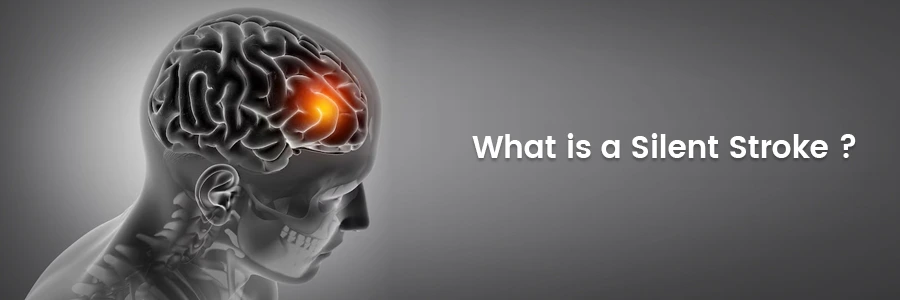- Cardiology 84
- Dermatology 45
- Endocrinology 33
- ENT 16
- Fertility 190
- Gastroenterology 78
- General-Medicine 81
- Gynecology 80
- Hematology 19
- Infectious-Diseases 33
- Neurology 52
- Oncology 34
- Ophthalmology 23
- Orthopedics 69
- Pediatrics 31
- Procedure 23
- Public-Health 144
- Pulmonology 59
- Radiology 8
- Urology 68
- Wellness 161
- Woman-and-child 77

Understanding What a Silent Stroke Is
A stroke happens when the brain stops receiving blood and can cause permanent damage and disability. Silent stroke is difficult to detect because it affects a part of the brain that does not regulate functions, such as speaking or moving.
These strokes occur when the blood flow to the part of the brain is suddenly cut off, depriving that portion of the brain of oxygen and causing damage to brain cells.
Secure your health with a second opinion. Make informed decisions and book your appointment today!
Get A Second OpinionWhat are the Silent Stroke Symptoms?
The patient may also experience additional symptoms which are mistaken for signs of ageing. They include:
- Loss of memory ( dementia)
- Problems in balancing
- Sudden changes in personality and mood
- Reduced memory
- Falling frequently
- Urine leakage
- Alteration in mood
- Reduced thinking ability
What Causes a Silent Stroke?
- For the brain to work correctly, blood must be oxygen-rich and flow freely.
- The signs of a stroke might differ depending on the part of the damaged brain.
- Before an actual stroke, a transient ischemic attack (TIA) or mini-stroke can also happen.
- People who have previously had a mini-stroke are far more likely to encounter a major one in the future. Mini-stroke symptoms might go away fast.
Ready to take control of your health journey? Book your appointment now and start your path towards wellness today!
Book an AppointmentHow Dangerous are Silent Strokes?
- Even though quiet strokes appear to be harmless, they can yet cause long-lasting harm.
- After multiple silent strokes, a person may have trouble remembering things and even struggle to concentrate.
- Silent strokes can result in emotional problems such as inappropriate crying or laughing, they can make a person feel disoriented in a normal place.
Managing a Silent Stroke: Prevention Tips You Must Follow
While it is difficult to detect a silent stroke and even more challenging to fix the parts that have already been damaged, you can only prevent it. There are several ways to prevent the condition. Some of them are:
Exercise
Exercising for 30 minutes daily reduces the chance of a silent stroke by 40%. Healthy people are less prone to develop it. Additionally, they are better equipped to recover in case of a situation.
Weight Management
The risk of a silent stroke is increased by obesity and excess weight. Patients who are obese are more prone to artery-blocking plaque. Healthy body weight is defined as 18.5 to 24.9 on the BMI index.
Manage Blood Pressure
Underlying medical issues such as high cholesterol, diabetes, and high blood pressure should be managed by patients. The risk of a silent stroke rises when these conditions continue.
Healthy Lifestyle
The risk of a silent stroke is also decreased by living a healthy and active lifestyle. Both drinking alcohol and smoking must be avoided. Cut down your salt intake.
Conclusion:
It is challenging and usually incomplete to repair injured brain tissue. Most of the time, the healthy parts of the brain replace the destroyed part's functions. However, the capacity of the brain to replace damaged tissues decreases in cases of silent stroke that progress silently over time.
Silent strokes can cause permanent brain damage; Therefore, medical professionals should treat the symptoms as soon as possible. Sudden changes in memory and cognitive function should not be avoided and should consult a doctor immediately.
Frequently Asked Questions
Silent strokes may not have obvious symptoms, but they can still cause damage to the brain and increase the risk of future strokes.
Silent strokes can be detected through brain imaging scans like MRI or CT scans, even if there are no noticeable symptoms.
Yes, silent strokes can affect memory and cognitive function over time, especially if they occur repeatedly.
Treatment focuses on managing underlying risk factors, such as controlling blood pressure and cholesterol levels, and lifestyle changes.
Long-term effects may include subtle changes in thinking, memory loss, or increased risk of future strokes.
Lifestyle changes like regular exercise, a healthy diet, managing blood pressure, and not smoking can help reduce the risk of silent strokes.

- Cardiology 2132
- Dermatology 168
- Endocrinology 135
- ENT 97
- Fertility 217
- Gastroenterology 232
- General 478
- General-Medicine 1685
- Gynecology 169
- Hematology 85
- Infectious-Diseases 208
- Neurology 207
- Oncology 345
- Ophthalmology 65
- Orthopedics 187
- Pediatrics 83
- Procedure 72
- Public-Health 209
- Pulmonology 126
- Radiology 13
- Second Opinion 311
- Urology 294
- Wellness 600
- Woman-and-child 447
- Others 10217
Related Blogs
If you have any questions, please fill out the enquiry form or call us, and we will get back to you promptly.
040-68334455